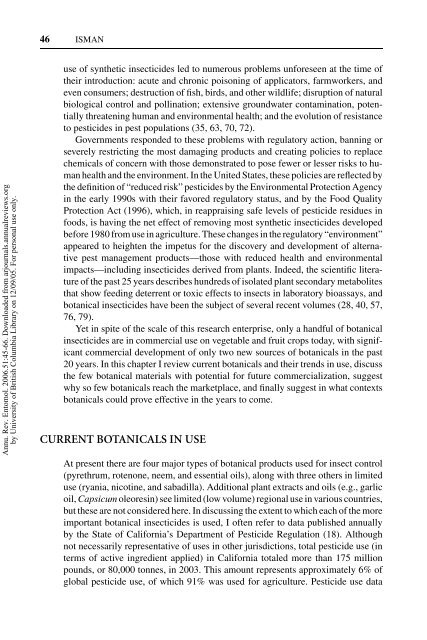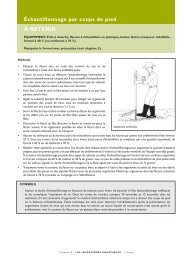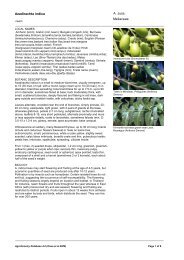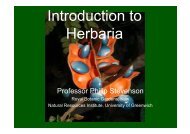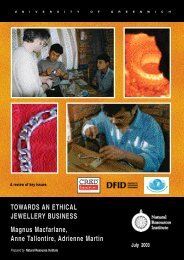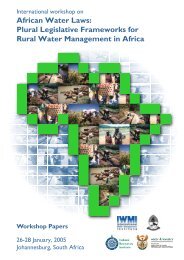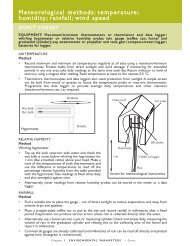botanical insecticides, deterrents, and repellents in modern ...
botanical insecticides, deterrents, and repellents in modern ...
botanical insecticides, deterrents, and repellents in modern ...
You also want an ePaper? Increase the reach of your titles
YUMPU automatically turns print PDFs into web optimized ePapers that Google loves.
Annu. Rev. Entomol. 2006.51:45-66. Downloaded from arjournals.annualreviews.org<br />
by University of British Columbia Library on 12/09/05. For personal use only.<br />
46 ISMAN<br />
use of synthetic <strong><strong>in</strong>secticides</strong> led to numerous problems unforeseen at the time of<br />
their <strong>in</strong>troduction: acute <strong>and</strong> chronic poison<strong>in</strong>g of applicators, farmworkers, <strong>and</strong><br />
even consumers; destruction of fish, birds, <strong>and</strong> other wildlife; disruption of natural<br />
biological control <strong>and</strong> poll<strong>in</strong>ation; extensive groundwater contam<strong>in</strong>ation, potentially<br />
threaten<strong>in</strong>g human <strong>and</strong> environmental health; <strong>and</strong> the evolution of resistance<br />
to pesticides <strong>in</strong> pest populations (35, 63, 70, 72).<br />
Governments responded to these problems with regulatory action, bann<strong>in</strong>g or<br />
severely restrict<strong>in</strong>g the most damag<strong>in</strong>g products <strong>and</strong> creat<strong>in</strong>g policies to replace<br />
chemicals of concern with those demonstrated to pose fewer or lesser risks to human<br />
health <strong>and</strong> the environment. In the United States, these policies are reflected by<br />
the def<strong>in</strong>ition of “reduced risk” pesticides by the Environmental Protection Agency<br />
<strong>in</strong> the early 1990s with their favored regulatory status, <strong>and</strong> by the Food Quality<br />
Protection Act (1996), which, <strong>in</strong> reapprais<strong>in</strong>g safe levels of pesticide residues <strong>in</strong><br />
foods, is hav<strong>in</strong>g the net effect of remov<strong>in</strong>g most synthetic <strong><strong>in</strong>secticides</strong> developed<br />
before 1980 from use <strong>in</strong> agriculture. These changes <strong>in</strong> the regulatory “environment”<br />
appeared to heighten the impetus for the discovery <strong>and</strong> development of alternative<br />
pest management products—those with reduced health <strong>and</strong> environmental<br />
impacts—<strong>in</strong>clud<strong>in</strong>g <strong><strong>in</strong>secticides</strong> derived from plants. Indeed, the scientific literature<br />
of the past 25 years describes hundreds of isolated plant secondary metabolites<br />
that show feed<strong>in</strong>g deterrent or toxic effects to <strong>in</strong>sects <strong>in</strong> laboratory bioassays, <strong>and</strong><br />
<strong>botanical</strong> <strong><strong>in</strong>secticides</strong> have been the subject of several recent volumes (28, 40, 57,<br />
76, 79).<br />
Yet<strong>in</strong>spite of the scale of this research enterprise, only a h<strong>and</strong>ful of <strong>botanical</strong><br />
<strong><strong>in</strong>secticides</strong> are <strong>in</strong> commercial use on vegetable <strong>and</strong> fruit crops today, with significant<br />
commercial development of only two new sources of <strong>botanical</strong>s <strong>in</strong> the past<br />
20 years. In this chapter I review current <strong>botanical</strong>s <strong>and</strong> their trends <strong>in</strong> use, discuss<br />
the few <strong>botanical</strong> materials with potential for future commercialization, suggest<br />
why so few <strong>botanical</strong>s reach the marketplace, <strong>and</strong> f<strong>in</strong>ally suggest <strong>in</strong> what contexts<br />
<strong>botanical</strong>s could prove effective <strong>in</strong> the years to come.<br />
CURRENT BOTANICALS IN USE<br />
At present there are four major types of <strong>botanical</strong> products used for <strong>in</strong>sect control<br />
(pyrethrum, rotenone, neem, <strong>and</strong> essential oils), along with three others <strong>in</strong> limited<br />
use (ryania, nicot<strong>in</strong>e, <strong>and</strong> sabadilla). Additional plant extracts <strong>and</strong> oils (e.g., garlic<br />
oil, Capsicum oleores<strong>in</strong>) see limited (low volume) regional use <strong>in</strong> various countries,<br />
but these are not considered here. In discuss<strong>in</strong>g the extent to which each of the more<br />
important <strong>botanical</strong> <strong><strong>in</strong>secticides</strong> is used, I often refer to data published annually<br />
by the State of California’s Department of Pesticide Regulation (18). Although<br />
not necessarily representative of uses <strong>in</strong> other jurisdictions, total pesticide use (<strong>in</strong><br />
terms of active <strong>in</strong>gredient applied) <strong>in</strong> California totaled more than 175 million<br />
pounds, or 80,000 tonnes, <strong>in</strong> 2003. This amount represents approximately 6% of<br />
global pesticide use, of which 91% was used for agriculture. Pesticide use data


